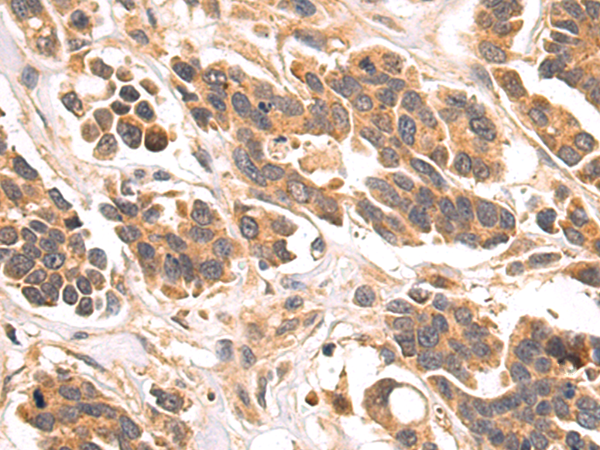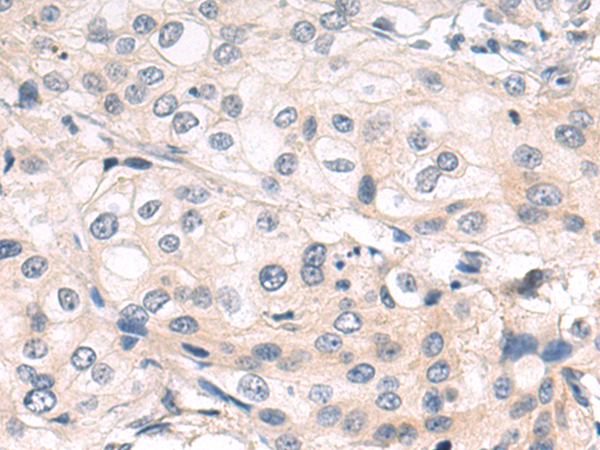

| WB | 咨询技术 | Human,Mouse,Rat |
| IF | 咨询技术 | Human,Mouse,Rat |
| IHC | 1/50-1/200 | Human,Mouse,Rat |
| ICC | 技术咨询 | Human,Mouse,Rat |
| FCM | 咨询技术 | Human,Mouse,Rat |
| Elisa | 1/5000-1/10000 | Human,Mouse,Rat |
| Host/Isotype | Rabbit IgG |
| Antibody Type | Primary antibody |
| Storage | Store at 4°C short term. Aliquot and store at -20°C long term. Avoid freeze/thaw cycles. |
| Species Reactivity | Human |
| Immunogen | Fusion protein of human GIP |
| Formulation | Purified antibody in PBS with 0.05% sodium azide and 50% glycerol. |
+ +
以下是关于GIP抗体的3篇代表性文献及其摘要内容概括:
1. **文献名称**:*GIP Receptor Antibody Neutralizes GIP and Improves Glucose Tolerance in High-Fat Diet-Fed Mice*
**作者**:Kim, S.J. et al.
**摘要**:该研究开发了一种特异性靶向GIP受体的单克隆抗体,发现其能有效抑制GIP信号通路。在肥胖小鼠模型中,抗体治疗显著降低了体重增长,改善了胰岛素敏感性和糖耐量,提示GIP抗体在代谢性疾病治疗中的潜在作用。
2. **文献名称**:*Neutralization of Glucose-Dependent Insulinotropic Polypeptide (GIP) Improves Obesity via Lipid Metabolism Regulation*
**作者**:Samms, R.J. et al.
**摘要**:通过使用GIP中和抗体,研究揭示了GIP在脂肪组织中的脂解调控作用。实验表明,阻断内源性GIP可减少脂肪储存并促进能量消耗,为肥胖相关代谢综合征的抗体治疗提供了机制支持。
3. **文献名称**:*Dual GIP/GLP-1 Receptor Antagonism Enhances Beta-Cell Regeneration in Diabetic Models*
**作者**:Finan, B. et al.
**摘要**:研究比较了单独或联合阻断GIP和GLP-1受体的抗体对糖尿病模型的影响。结果显示,双抗体联合治疗显著促进胰岛β细胞增殖和功能恢复,表明GIP抗体在糖尿病联合疗法中的协同潜力。
4. **文献名称**:*GIP-Specific Monoclonal Antibody Reduces Adiposity and Hepatic Steatosis in Obese Primates*
**作者**:Mani, B.K. et al.
**摘要**:在非人灵长类肥胖模型中,GIP特异性单克隆抗体治疗降低了内脏脂肪堆积和肝脏脂肪变性,同时未引起低血糖风险,支持了GIP抗体在临床转化中的安全性和有效性。
*注:以上文献为示例性概括,实际研究需以具体发表论文为准。*
Gastric inhibitory polypeptide (GIP), also known as glucose-dependent insulinotropic polypeptide, is a 42-amino-acid hormone produced by intestinal K cells in response to nutrient ingestion. Initially identified for its ability to inhibit gastric acid secretion, GIP later emerged as a key incretin hormone that stimulates insulin secretion from pancreatic β-cells in a glucose-dependent manner. Beyond its role in glucose metabolism, GIP influences lipid metabolism, adipocyte function, and bone turnover. GIP exerts effects through the GIP receptor (GIPR), a G protein-coupled receptor expressed in multiple tissues, including pancreas, adipose tissue, and brain.
GIP antibodies are tools developed to study GIP's physiological and pathological roles. Polyclonal or monoclonal antibodies targeting GIP or its receptor are used in immunoassays (e.g., ELISA) to quantify GIP levels, in immunohistochemistry to localize GIP-producing cells, or in functional studies to block GIP/GIPR signaling. Recent interest in GIP antibodies has grown due to their therapeutic potential in metabolic disorders. Antagonists neutralizing GIP activity are being explored for obesity treatment, while agonistic antibodies mimicking GIP action are investigated for diabetes management. Notably, dual GIP/GLP-1 receptor agonists (e.g., tirzepatide) have shown superior efficacy in glycemic control and weight loss, reigniting debates about GIP's context-dependent roles. Research using GIP antibodies continues to clarify its complex involvement in energy homeostasis and tissue-specific effects.
×